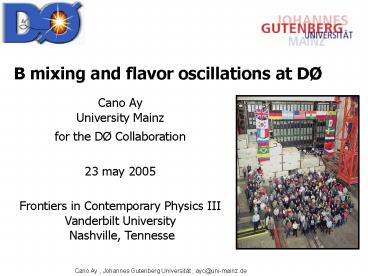Folie 1 - PowerPoint PPT Presentation
1 / 27
Title:
Folie 1
Description:
Particle Antiparticle. The transition of a neutral. particle into its antiparticle is. called Mixing. Mixing. 23 may 2005. FCP III , Cano Ay ... – PowerPoint PPT presentation
Number of Views:13
Avg rating:3.0/5.0
Title: Folie 1
1
B mixing and flavor oscillations at DØ
Cano Ay University Mainz for the DØ
Collaboration 23 may 2005 Frontiers in
Contemporary Physics III Vanderbilt University
Nashville, Tennesse
Cano Ay , Johannes Gutenberg Universität ,
ayc_at_uni-mainz.de
2
Outline
- Motivation
- Mixing and Oscillation
- Tevatron and DØ Detector
- Flavor tagging
- Bd Mixing Limit
- Bs Mixing Limit
- Prospects and plans
- Summary
3
Motivation
- The ratio Dms/Dmd constrains one side of the
unitarity triangle - also study CP violation in Bs system
- studied in Kaon and Bd system
- Belle and Babar not sensitiv
- LHCB not running
- Tevatron currently only place to study Bs Mixing
4
Mixing
Particle ? Antiparticle
The transition of a neutral particle into its
antiparticle is called Mixing.
5
Unitarity triangle
Standard Model expectation ?ms 14
....28ps-1 ?md 0.5ps-1 measurement of
?ms/?md ? Vts/Vtd constrain unitarity
triangle
6
Mixing (2)
high uncertainties f(QCD)
reduce uncertainties by taking ratio
Measure Dm ? asymmetry
7
Mixing (3)
- From the CKM fit Dms 18 ps-1
- Heavy Flavor Averaging group
- combined LEP, SLD, CDF1 results
- Dms gt 14.5 ps-1
flavor tagging performance resolution
selection
8
Tevatron
Big advantage for B physics Bs meson production
9
Luminosity
10
D0 Detector
- Semileptonic decays
- trigger on muon
- good muon system
- reconstruct tracks and vertex
- good tracking system
11
Silicon Microstrip Tracker (SMT)
- Silicon Microstrip Tracker
- 800.000 channels
- point resolution 10?m
- Secondary vertex resolution
- 40?m (r-?)
- 80?m (r-z)
- Trackers
- Silicon Tracker ?lt3
- Fiber Tracker ?lt2
- Magnetic field 2T
12
Muon Sytem
- 2 Tesla toroid magnet between A und
- BC Layer ? Muon momentum
- propotional drift tubes
- pixel scintillators
- Muon system coverage ?lt2 and
- good shielding
A minidrift tube with cover partially removed
13
B production and decay
B production Fermilab s O(100µb) L1 Trigger
acceptance (DØ Muon) s O(3-5µb)
Used Decays
B0s ? D-s µnµ D-s ? ?(KK-)?-
B0d ? D(2010)-µ nµ D(2010)-?D0(K?-)?
- B ? D0µ nµ D0? K-?
14
Flavor tagging
Flavor tagging determine b-flavor at production
time!
reconstructed side
opposite side
oscillated not oscillated
- Soft Lepton Tag (SLT)
- Opposite Jet charge (Jetq)
- Same Side Tag
- (currently only used for Bd)
15
Bd Sample
- angle and distance
- distance PV ? D Vertex (xy-plane)
- D Vertex not before B Vertex
- Angle between PV ? B Vertex
- and PV ? D Vertex
- Charged tracks
- pT gt 0.65 GeV/c
- impact parameter significance
Single µ data 200pb-1
16
Bd Mixing Limit
SLT D0 (44.8?5.1) JetqSST D0
(14.9?1.5)
JetqSST D? 27.9
Asymmetry
Asymmetry
Dmd0.456?0.034ps-1(stat) ?0.025ps-1(syst)
consistent with Dmd0.502?0.007ps-1 (world
average)
17
Bs Mixing analysis procedure
- Currently only using a single semileptonic
decay of the Bs - Bs ? Ds ? X (Ds ?? p) (? ? K K)
- Using ? SV vertex tag (Opposite side tag,
independent of reconstructed side) - The goal was to develop tools and to allow a
baseline to build on for the future
18
Bs Sample
- Charged tracks
- pT gt 0.7 GeV/c
- impact parameter significance
- Invariant KK mass
- 1.006 lt M(KK) lt 1.30
- angle and distance
- distance PV ? D Vertex (xy-plane)
- D Vertex not before B Vertex
- Angle between PV ? B Vertex and PV ? D Vertex
- Angle between PV ? D Vertex and D momentum
19
Bs Mixing fitting procedure
- Inputs to the fitting procedure
- MC
- Sample composition
- K-factor to take non-reconstructed particles
into account - Efficiencies
- Visible Proper Decay Length (VPDL) resolution
- VPDL resolution has been tuned using data
- Dilution from B0d and Bu semileptonic samples
20
Sample Composition and efficiency
Decay Sample composition
Bs?Dsµ? 20.6
Bs?Dsµ? 57.2
Bs?D0sµ? 1.4
Bs?D1sµ? 2.9
Bs?DsDsX 11.3
B0?DsDX 3.2
B-?DsDX 3.4
VPDL (cm)
Efficiency drop at low VPDL due to impact
parameter cuts on tracks from Ds decay
21
K-factors
K
K x VPDL
Decay ltkgt
Bs?Dsµ? 0.878
Bs?Dsµ? 0.857
Bs?D0sµ? 0.829
Bs?D1sµ? 0.817
Bs?DsDsX 0.738
B0?DsDX 0.681
B-?DsDX 0.687
22
VPDL Resolution MC tuned with data
- VPDL resolution parametrized with three Gaussians
- Track by track
- smearing dependant on track momentum and polar
angle - Tuning results with one scale factor 1.095
no smearing after smearing
VPDLrec VPDLgen cm
23
Dilution
- SLT SV Jetq D0 (39.0?3.2) D?
(47.6?2.0) - use mean Davr(45.4?1.7) for Bs asymmetry
24
Bs Mixing Limit
No obvious oscillations in the µDssample
Dms gt 5.0 ps-1 at 95 CL using Amplitude
method
25
Sensitivity vs. Luminosity Semileptonic channels
- Scaling of the current sensitivity with
luminosity - if analysis remains
- unchanged
- with expected
- improvements
26
Bs Mixing Projections
- Use both semileptonic and hadronic Bs samples
- More statistics in semileptonics
- Better proper decay time resolution in hadronics
(no n) - DZero has access to hadronic Bs sample triggering
on opposite side muon - Muon is used as high purity tag
- Detector addition in fall
- Layer 0 Silicon detector
- Proposal to increase rate to tape from 50 to 100
Hz in fall - sample limited by L3 trigger and offline CPU
expect large gain in yield thanks - to dedicated B-physics bandwidth
27
Summary
- measured, which is in agreement with world
average - Dmd0.456?0.034ps-1(stat) ?0.025ps-1(syst)
- developed a procedure to measure Dms using
semileptonic channel Bs?Ds(??)??? - Dms gt 5.0ps-1 at 95 CL
- will add more semileptonic channels and hadronic
channels - Layer 0 Silicon detector and increasing L3
rate will improve resolution and increase
statistics































